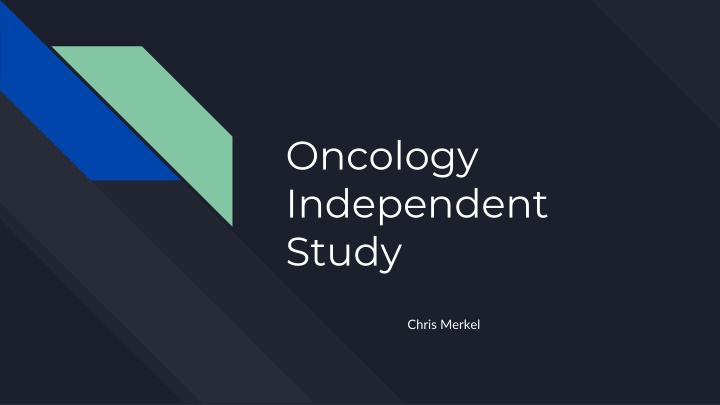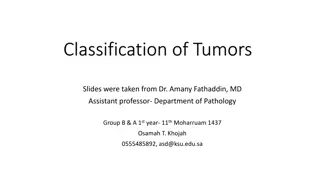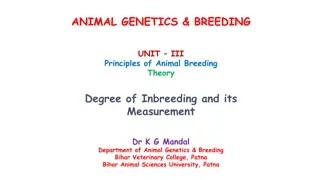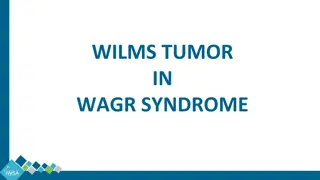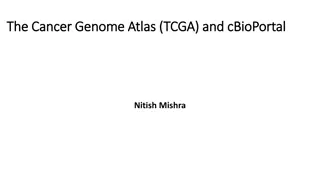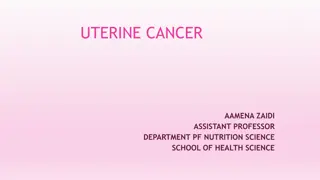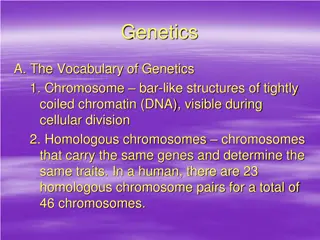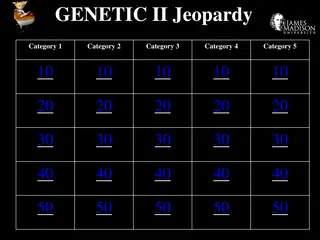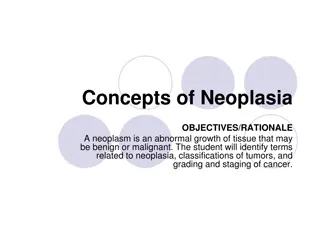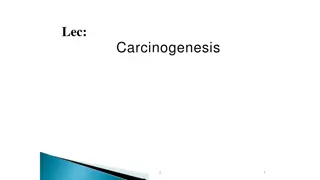Cancer Genetics: Oncogenes, Tumor Suppressor Genes, and Epigenetics
Cancer is a complex disease involving mutations in oncogenes, tumor suppressor genes, loss of heterozygosity events, and epigenetic factors. Learn about the molecular mechanisms driving cancer progression.
Download Presentation

Please find below an Image/Link to download the presentation.
The content on the website is provided AS IS for your information and personal use only. It may not be sold, licensed, or shared on other websites without obtaining consent from the author.If you encounter any issues during the download, it is possible that the publisher has removed the file from their server.
You are allowed to download the files provided on this website for personal or commercial use, subject to the condition that they are used lawfully. All files are the property of their respective owners.
The content on the website is provided AS IS for your information and personal use only. It may not be sold, licensed, or shared on other websites without obtaining consent from the author.
E N D
Presentation Transcript
Oncology Independent Study Chris Merkel
What is Cancer? Cancer is a disease where a mass of cells has acquired enough mutations to deregulate normal healthy function Once this occurs then they may start to crowd out normal cells around them Local tumor- benign Invasive tumor- malignant Cancer is not just one disease
Oncogenes In healthy cells, there s proto-oncogenes that tell the cell to advance in the cell cycle and proliferate When mutated, they re called oncogenes and act as a gas pedal Oncogenes are difficult for the tumor to obtain because the mutation has to improve, not disable the protein
Tumor Suppressor Genes (TSGs) TSGs are the opposing type of gene to the oncogenes They prevent the cell from advancing through the cell cycle, acting as the brake pedal Mutating these tumor suppressor genes is much more feasible because you only have to deactivate it However you still need to mutated both alleles which seemed much to unlikely to deactivate a gene solely relying on mutations
Loss of Heterozygosity (LOH) Events First discovered was the process of mitotic recombination which happens more frequently than mutations Yet another, more frequent event was found where polymerase may begin replicating, jump to the other allele, and then jump back to the first strand and continue copying
Epigenetics Epigenetics Hank his clone Circus Hank explain the power of epigenetics, which studies the factors that determine how much or whether some genes are expressed in your body. Like SciShow on Facebook! http://www.facebook.com/scishow Follow SciShow on Twitter! http://www.twitter.com/scishow More SciShow! Solar Energy - http://youtu.be/4uPVZUTLAvA Foldit Gamers FTW - http://youtu.be/JdBcpdH_ptA
p53 p53 has similar characteristics to that of a TSG, but it doesn t behave exactly the same. It doesn't operate to code for proliferative signals, instead it prevents the appearance of abnormal cells p53 is a homotetramer, so when an allele gets mutated, it produces a dysfunctional copy of the protein The mutant p53 also has a hyperactive promoter
p53 - Continued p53 is a transcription factor so the levels of it must be able to elevate or decrease in response to external factors p53 specifically is very unstable, so broken down shortly after synthesis When p53 receives an alarm signal it will then put the cell in growth arrest or even trigger apoptosis Double-stranded breaks Any agents toxic to the genome Excessive growth p53 is so vital to genomic integrity that without it cells are much more susceptible to accumulating mutations
Apoptosis If conditions are too extreme, p53 will trigger apoptosis The plasma membrane blebs Nucleus collapses into itself then breaks up DNA is broken into many small segments Macrophages and nearby cells engulf the cell body Intrinsic Apoptosis- stress activated, internal signals trigger apoptosis Extrinsic Apoptosis- receptor activated, a signal binds to receptors on the outside of the cell called death receptors
Tumorigenesis Tumor progression is the transition of normal cells into cells with increasingly neoplastic phenotypes Hyperplasia- epithelium appears thicker than normal because rate of division is high Dysplasia- morphology of cells is altering slightly Polyps/Adenomas- larger growths that will actually appear on diagnostic imaging These stages can act as stepping stones to malignancy, but may also be dead ends for some Clinical studies show that those who get polyps removed have an 80% reduction in the incidence of colon carcinoma Epigenetic changes in tumor progression mimic those in embryological development
Clonal expansions and Genomic Instability A random mutation creates a cell that has an advantage over another This cell then multiplies and crowds out the other cells until it gets large enough for another mutation As tumor progression advances, tumor genomes became increasingly unstable In a single tumor there will be a number of genetically distinct subclones
Clonal Expansions Only a small portion of cells in a tumor are capable of producing new tumors Resembles the role of stem cells All tumors must have certain changes to grow, but the genes affected are not always the same Mitotic signalling pathway Cell cycle checkpoints Alarm pathway
Angiogenesis and Hypoxic Environments Angiogenesis is the process of tumors releasing signals to draw blood vessels towards them This allows them to grow larger and increase their metabolism These blood vessels are very poorly constructed and sometimes don't work Angiogenesis inhibitors were thought to be the final cure for all cancer because it would cut off blood flow, then killing the cancer in theory. Hypoxic environments (lacking oxygen) provoke tumors and cause them to become much stronger, activating pathways to help them survive short-term and long-term
Metastasis and Malignancy Metastasizing is when cells of a tumor can break off of the primary tumor into a vessel and move throughout the body In carcinomas, the tumor must break through the basement membrane of the epithelium Degrading the basement membrane the cells have access to lots of growth factors and survival signals in the stroma Now the tumor can move through walls and into blood and lymph vessels When a cancer cell breaks through the basement membrane it undergoes an epithelial- mesenchymal transition (EMT) Entering a vessel is called intravasation
Metastasizing Through the Body How does cancer spread through the body? - Ivan Seah Yu Jun View full lesson: http://ed.ted.com/lessons/how-does-cancer-spread-through-the-body-ivan-seah-yu-jun Cancer usually begins with one tumor in a specific area of the body. But if the tumor is not removed, cancer has the ability to spread to nearby organs as well as places far away from the origin, like the brain. How does cancer move to these new areas and why are some organs more likely to get infected than others? Ivan Seah Yu Jun explains the three common routes of metastasis. Lesson by Ivan Seah Yu Jun, animation by Andrew Foerster.
Landing and Forming New Colonies Once the cells leave vessels (extravasation) they may not survive in the new stromal environment because they are not getting the same growth factors and nutrients as before May undergo a reverse of the EMT, a mesenchymal-epithelial transition (MET) A metastasis is only significant when it is over 2 mm in diameter, termed macrometastasis Metastasis is most common to land in the bone because there s lots of growth factors and nutrients for them to grow
